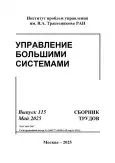Controlling opinions in the scardo-model of opinion dynamics with two-element opinion alphabet and single type of native agents: analytical solution
- Authors: Gezha V.N.1, Kozitsin I.V.2
-
Affiliations:
- Moscow Institute of Physics and Technology
- V.A. Trapeznikov Institute of Control Sciences of RAS, Moscow, Moscow Institute of Physics and Technology
- Issue: No 115 (2025)
- Pages: 6-32
- Section: Systems analysis
- URL: https://bakhtiniada.ru/1819-2440/article/view/306189
- ID: 306189
Cite item
Full Text
Abstract
About the authors
Vladislav Nikolaevich Gezha
Moscow Institute of Physics and Technology
Email: gezha.vn@phystech.edu
Moscow
Ivan Vladimirovich Kozitsin
V.A. Trapeznikov Institute of Control Sciences of RAS, Moscow, Moscow Institute of Physics and Technology
Email: kozitsin.ivan@mail.ru
Moscow
References
- ГУБАНОВ Д.А., НОВИКОВ Д.А., ЧХАРТИШВИЛИ А.Г.Социальные сети: модели информационного влияния, управ-ления и противоборства / Под. ред. чл.-корр. РАН Д.А, Но-викова. – М.: Физматлит, 2010. – 228 с.
- ГУБАНОВ Д.А. Модели и методы информационного влия-ния и управления в активных сетевых структурах : дис. ...докт. техн. наук. – М., 2021.
- BALIETTI S. et al. Reducing opinion polarization: Effectsof exposure to similar people with differing politicalviews // Proc. of the National Academy of Sciences. –2021. – Vol. 118, No. 52. – P. e2112552118. – DOI:https://doi.org/10.1073/pnas.2112552118.
- BINI M. et al. Graph structure-based heuristics for optimaltargeting in social networks // IEEE Trans. on Control ofNetwork Systems. – 2022. – Vol. 9, No. 3. – P. 1189–1201. –DOI: https://doi.org/10.1109/TCNS.2022.3163665.
- EPSTEIN R. et al. The “opinion matching effect”(OME): Asubtle but powerful new form of influence that is apparentlybeing used on the internet // PloS One. – 2024. – Vol.19, No. 9. – P. e0309897. – DOI: https://doi.org/10.1371/journal.pone.0309897.
- FLACHE A. et al. Models of social influence: Towardsthe next frontiers // The Journal of Artificial Societies andSocial Simulation. – 2017. – Vol. 20, No. 4. – P. 2. – DOI:https://doi.org/10.18564/jasss.3521.
- FRIEDKIN N.E. The problem of social control andcoordination of complex systems in sociology: A look atthe community cleavage problem // IEEE Control SystemsMagazine. – 2015. – Vol. 35, No. 3. – P. 40–51. – DOI:https://doi.org/10.1109/MCS.2015.2406655.
- GEZHA V.N., KOZITSIN I.V. Binary Opinion Space in theSCARDO Model: Precise Analytical Description // Advancesin Systems Science and Applications. – 2022. – Vol. 22,No. 4. – P. 103–115. – DOI: https://doi.org/10.25728/assa.2022.22.4.1292.
- GEZHA V.N., KOZITSIN I.V. Macroscopic Descriptionof Structured Heterogeneous Online Social Systems withDynamical Opinions // 6th Int. Conf. on Control Systems,Mathematical Modeling, Automation and Energy Efficiency(SUMMA–2024). – IEEE, 2024. – P. 133–138. – DOI: https://doi.org/10.1109/SUMMA64428.2024.10803880.
- HUNTER R.F. et al. Social network interventions forhealth behaviours and outcomes: A systematic review andmeta-analysis // PLoS Medicine. – 2019. – Vol. 16,No. 9. – P. e1002890. – DOI: https://doi.org/10.1371/journal.pmed.1002890.
- KEIJZER M.A., MAS M., FLACHE A. Polarization on socialmedia: Micro-level evidence and macro-level implications //JASSS. – 2024. – Vol. 27, No. 1. – P. 7. – DOI: https://doi.org/10.18564/jasss.5298.
- KOZITSIN I.V. A general framework to link theory andempirics in opinion formation models // Scientific Reports. –2022. – Vol. 12, No. 1. – P. 5543. – DOI: https://doi.org/10.1038/s41598-022-09468-3.
- KOZITSIN I.V. Opinion dynamics of online social networkusers: a micro-level analysis // The Journal of MathematicalSociology. – 2023. – Vol. 47, No. 1. – P. 1–41. – DOI: https://doi.org/10.1080/0022250X.2021.1956917.
- KOZITSIN I.V. Optimal control in opinion dynamics models:diversity of influence mechanisms and complex influencehierarchies // Chaos, Solitons & Fractals. – 2024. – Vol. 181. –P. 114728. – DOI: https://doi.org/10.1016/j.chaos.2024.114728.
- LEE C., WILKINSON D.J. A review of stochastic blockmodels and extensions for graph clustering // Applied NetworkScience. – 2019. – Vol. 4, No. 1. – P. 1–50. – DOI:https://doi.org/10.1007/s41109-019-0232-2.
- LI G.J., PORTER M.A. Bounded-confidence model of opiniondynamics with heterogeneous node-activity levels // PhysicalReview Research. – 2023. – Vol. 5, No. 2. – P. 023179. – DOI:https://doi.org/10.1103/PhysRevResearch.5.023179.
- PERALTA A.F., KERTESZ J., INIGUEZ G. Opinion formationon social networks with algorithmic bias: dynamics and biasimbalance // Journal of Physics: Complexity. – 2021. – Vol. 2,No. 4. – P. 045009. – DOI: https://doi.org/10.1088/2632-072X/ac340f.
- PROSKURNIKOV A.V., TEMPO R. A tutorial on modelingand analysis of dynamic social networks. Part II // AnnualReviews in Control. – 2018. – Vol. 45. – P. 166–190. – DOI:https://doi.org/10.1016/j.arcontrol.2018.03.005.
- TANG T., SNIJDERS T., FLACHE A. An Empirical andSimulation Investigation of Bounded Confidence and NegativeInfluence in Opinion Dynamics Using Stochastic Actor-Oriented Model // Journal of Artificial Societies and SocialSimulation. – 2025. – Vol. 28, No. 1. – P. 1–2. – DOI: https://doi.org/10.18564/jasss.5566.
- VAROL O. et al. Online human-bot interactions: Detection,estimation, and characterization // Proc. of the Int. AAAI Conf.on Web and Social Media. – 2017. – Vol. 11, No. 1. – P. 280–289. – DOI: https://doi.org/10.1609/icwsm.v11i1.14871.
- ZIMMARO F., CONTUCCI P., KERTESZ J. Voter-likedynamics with conflicting preferences on modular networks //Entropy. – 2023. – Vol. 25, No. 6. – P. 838. – DOI: https://doi.org/10.3390/e25060838.
Supplementary files










